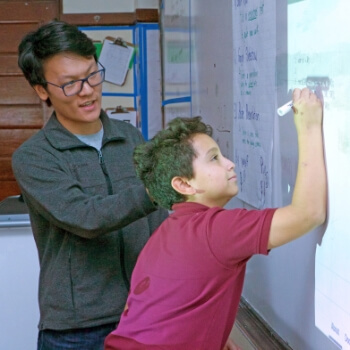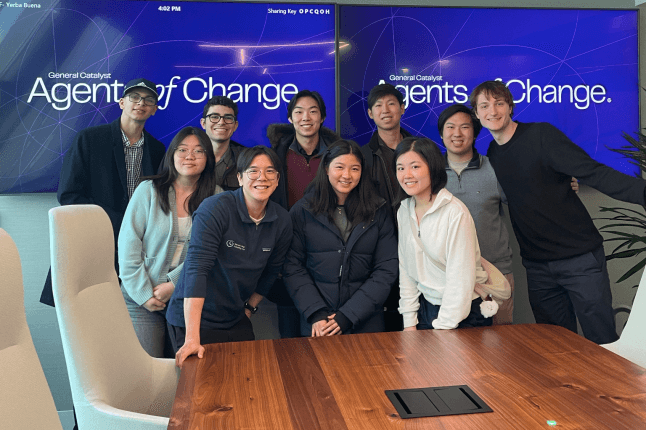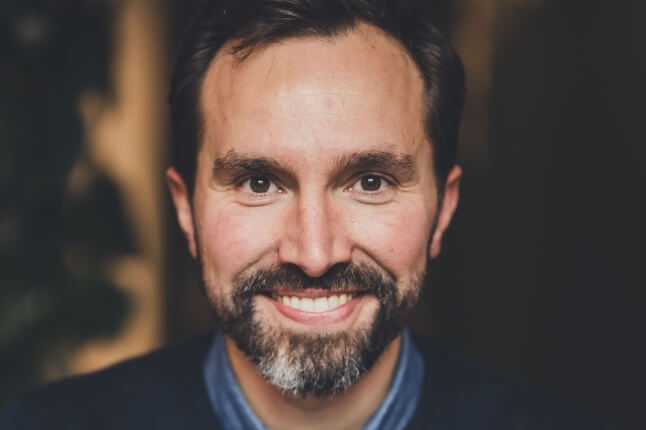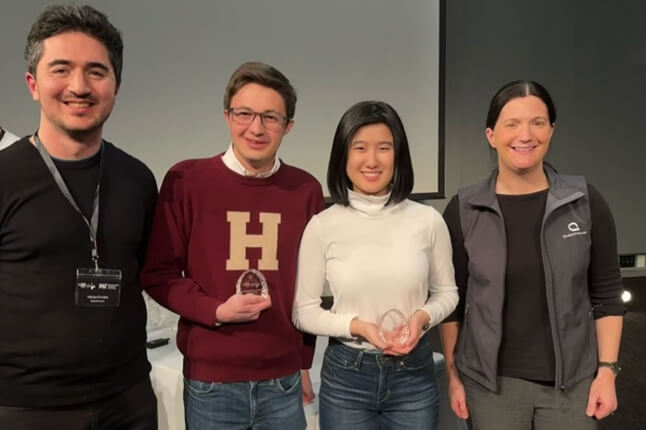News
Harvard student Chris Zhou, A.B. '19, an economics concentrator, helps Garder Pilot Academy sixth-grader Jonathan Gonzalez write Javascript functions on the classroom's white board during a Digital Literacy Project lesson. (Photo by Adam Zewe.)
Eager students lean forward in their seats to watch an animated car drive across the screen at the front of the classroom. Hands suddenly shoot into the air as the classmates consider the instructor’s question about the relevant JavaScript functions.
While it could be a scene from a computer science course at the Harvard John A. Paulson School of Engineering and Applied Sciences (SEAS), in this case SEAS students are the instructors, teaching programming to a class of middle schoolers at the Gardner Pilot Academy in Boston’s Allston neighborhood.
The instructors, members of the Harvard student-driven Digital Literacy Project (DLP), are working through one lesson in a 10-week computer science curriculum the organization is offering at seven local middle schools this year. The DLP outreach model is unusual because lessons are presented during the school day.
“Just as these students might go to art class or music class, they are also going to get a taste of computer science,” said DLP President Sundar Solai, A.B. ’19, a computer science concentrator. “Our hope is that, five or six years down the line when it is time for these students to consider careers or attending a university, they have an interest in pursuing STEM or computer science.”
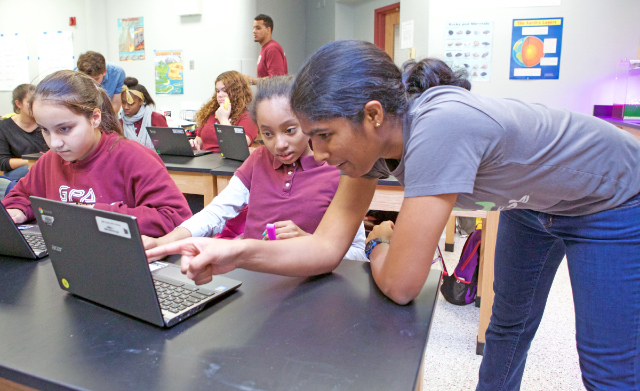
Freshman Suriya Kandaswamy, who intends to concentrate in computer science, explains a coding problem to Gardner Pilot Academy seventh-grade student Diamonique Marmoucha. (Photo by Adam Zewe/SEAS Communications.)
About 30 DLP volunteers teach introductory computer science in 12 middle school classes each week. The curriculum offers an introduction to coding concepts using the image-based programming language Scratch, before moving on to more advanced coding practice in JavaScript. Harvard students develop course materials, which are carefully designed to be fun and interactive, Solai said.
Members of the DLP technology team also create tools and coding examples to enhance classroom instruction. Crafting those coding problems often reinforces techniques the students learn in their Harvard courses, said Brian Sapozhnikov, A.B. ’19, a computer science concentrator who directs the technology team.
“We strive to ensure our volunteers are up to speed on how to solve a wide variety of computer science problems. That kind of training is invaluable for someone who is interested in pursuing any field that requires engineering solutions,” he said. “In teaching, they need to understand the material. In writing code to solve problems, they need to understand the problems.”
In addition to helping members sharpen programming skills, DLP provides volunteers with an instructor’s perspective on education, said Solai. Many go on to serve as Harvard teaching fellows, and some students have pursued careers at educational firms like Khan Academy.
While middle school students can sometimes be a tough audience, helping them develop skills and build confidence is rewarding, said Maria McLaughlin, A.B. ’18, a computer science concentrator. She was introduced to programming in college, and credits her computer science training with improving her creativity and logic. Often, the middle school students she teaches have an “ah-ha” moment when they realize programming is not magic, but a skill they can learn, she said.
“I love seeing the programs that my students come up with and the light in their eyes when they get something to work for the first time,” said McLaughlin. “It is an addictive feeling—to dream something up and then see it become a reality before your eyes. I want to share that feeling with others.”
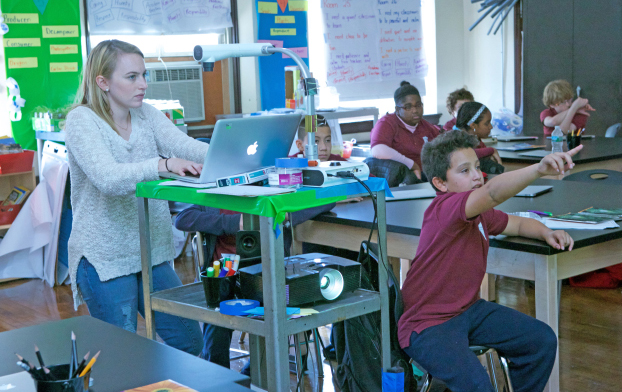
Computer science concentrator Maria McLaughlin, A.B. '18, leads a class of Gardner Pilot Academy sixth-graders through a Digital Literacy Project lesson on Javascript functions. (Photo by Adam Zewe/SEAS Communications.)
The STEM lessons McLaughlin and her peers provide are also important for DLP partner schools, many of which face resource challenges.
“As a full-service school, we work with partners to close the opportunity gaps that exist for our students,” said Lauren Fogarty, director of extended learning time at the Gardner Pilot Academy. “As an urban public school we do not readily have access to the STEM opportunities beyond our core science curriculum and the Digital Literacy Project closes that gap. DLP not only provides engaging coding experiences for our students, but also gives our students access to our local university students.”
The DLP leadership team plans to continue expanding to more schools, while developing new teaching tools and introducing the use of hardware into lessons. They are also considering hosting a community workshop to familiarize middle school teachers with introductory computer science materials they could easily incorporate into classes.
“The field of computer science is going to become even more prominent in the future,” said Sapozhnikov. “By exposing these students to computer science at a young age, we are opening up opportunities for them in high school, college, and beyond.”
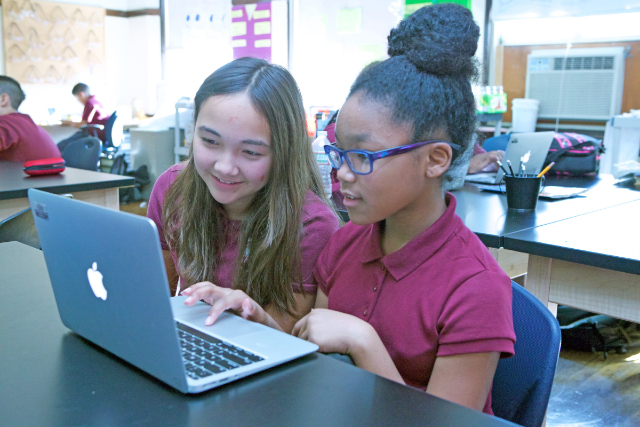
Gardner Pilot Academy sixth-grade students Amara Garbarino (left) and Rahneya Chhay collaborate to tackle a computer science problem set during a Digital Literacy Project lesson. (Photo by Adam Zewe/SEAS Communications.)
Topics: Computer Science
Cutting-edge science delivered direct to your inbox.
Join the Harvard SEAS mailing list.
Press Contact
Adam Zewe | 617-496-5878 | azewe@seas.harvard.edu
